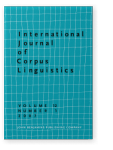Vol. 12:1 (2007) ► pp.107–118
Constraints on multiple initial embedding of clauses
The received view is that there are no constraints on clausal embedding complexity in sentences. This hypothesis will be challenged here on empirical grounds from the viewpoint of multiple initial embedding of clauses. The data come from the British National Corpus, Brown, LOB, and philological scholarship. The results extend to several other ‘Standard Average European’ (SAE) languages like Finnish, German, Latin, and Swedish. There is a precise quantitative constraint on the degree of initial clausal embedding, and that limit is two. In double initial embeddings, a qualitative constraint prescribes that typically the highest embedded clause is an if-clause. The lower embedded clause should be the sentential subject of the if-clause. Here is a real example of a maximally complex, prototypical, initial clausal embedding in mainstream SAE: [Main [Init–1 If [Init–2 what is tantamount to dictatorship …] continues in a union] it can …] (LOB). Multiple initial self-embeddings are prohibited.
Cited by
Cited by 6 other publications
This list is based on CrossRef data as of 31 march 2024. Please note that it may not be complete. Sources presented here have been supplied by the respective publishers. Any errors therein should be reported to them.
